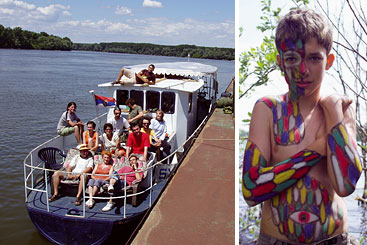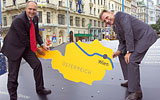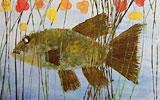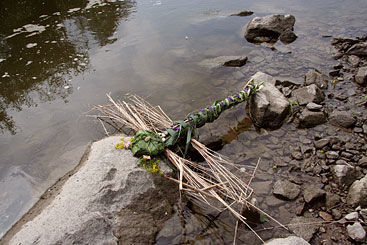
Danube Day 2007:
protecting our
river, protecting
our cultures
Massive celebrations for Danube Day 2007 brought together 14 countries in the most international river basin in the world. More than 300 organisations took part, with thousands of people gathering to pay tribute to the river that unites them.

Celebrations across the basin reflected the diverse cultures and traditions of the people living along the Danube and its tributaries. Credit: Various
The theme of Danube Day, ‘celebrating Danube
cultures’, inspired people across the Danube basin,
with folk groups, dancing, music, colourful costumes
and traditional crafts. The Prut River in
Moldova played host to a folk festival, with dancing,
costumes, music and craft stalls. “Preserving Danube
cultures gives Moldova a chance to be closer
to european values”, said Dumitru Drumea, head of
Delegation for Moldova of IcPDR.
In Slovakia, almost 500 children with their families enjoyed cultural performances alongside scientific demonstrations, discussion forums and a chance to meet turtles.
In Vienna, Austria, a 10m by 5m puzzle of the Danube Basin inspired residents and visitors by the many connections and influences that exist between the countries of the basin. “The Danube River is a European lifeline that also binds us in joint responsibility to do everything possible to preserve this common living and cultural environment”, said Ursula Plassnik, Federal Minister for European and International Affairs.
 “Water is the
blood of life.
Protect the river
for the next
generation.” Peter
visvader, Director
of the Public
Relation Department,
Ministry of
the environment
“Water is the
blood of life.
Protect the river
for the next
generation.” Peter
visvader, Director
of the Public
Relation Department,
Ministry of
the environmentEducation and learning. Education was a focus for many countries – through field trips, eco-camps, environmental competitions, scientific demonstrations, talks and films. More than 200 people visited the Danube Delta Biosphere Reserve in Ukraine as part of an associated campaign to raise awareness of theecological importance of the river and the need for environmental protection. “There are no similar regions where the river unites a whole group of countries located on its banks – it is more than just a geographical notion”, said Aleksandr Voloshkeyvych, Director of the Danube Delta Biosphere Reserve.
Practical actions to make a difference. Many Danube Day celebrations were accompanied by hands-on projects to help clean up the river and educate people about how their actions can contribute to change. A major clean-up project took place in Belgrade, at the Lido Beach on the river island of Veliko ratno ostrvo.
In Miskolc, Hungary, there was a fascinating exhibition
of messages and art in PET bottles, as well as a
huge raft of PET bottles on display, which was floated
down the Bodrog River from Slovakia. PET bottles are
the most visible form of rubbish found on the river,
and focusing on them in this event inspired students
to get involved for cleaner rivers.
 The Danube Art Master
Competition inspired
children across the basin
to think about the long
journey their river takes
through many different
lands across Europe.
The Danube Art Master
Competition inspired
children across the basin
to think about the long
journey their river takes
through many different
lands across Europe.Art and inspiration for the river. The Danube Art Master competition had another successful year, inspiring more children than ever across the basin to participate in an international competition to celebrate the Danube and its tributaries (see article on page 9). In Germany, children and young people from the upper reaches of the Danube were asked to think about the long journey their river takes through many different lands and cultures across Europe. Inspired by these connections, children created works of art that reflected the Danube’s value. “The Danube is a mirror of our lives: diverse, constantly changing and solid at the same time”, said Wolfgang Kunert, Head of Government, Administration District Oberpfalz.
Danube Day events in the Czech Republic highlighted both the protection of the environment and the celebration of art and culture. In Prague and Uherské Hradiště, more than 200 pupils watching screenings of Czech and international environmental films to educate a new generation about the importance of nature and ecological issues.
Celebrating Danube cultures. Mixing art with serious concern for the environment, students from the Biotechnology Education Centre in Ljubljana, Slovenia, created a traditional Water Dragon, the city’s symbol, in front of Municipality House. Using stone from the Sava River, they shaped the fantastic dragon sculpture to draw attention to the importance of conservation for both the Sava and Danube Rivers.
Danube Day coincided this year with celebrations of the 115th anniversary of the birth of Bosnia’s famous Nobel-prize-winning author Ivo Andric, whose novel ‘The Bridge over Drina’ celebrates the construction of the old bridge in Visegrad during the Turkish period. Each chapter of the book ends with a few sentences about rivers and bridges, and their connection to life. Celebrations and round tables on Andric’s work took place in schools across the whole country.

Promoting cross-border cooperation. Danube Day served as a forum to inspire new ways of working together. An international conference on the Danube in Ruse, Bulgaria, brought together Bulgarian regional officials and representatives of international organisations to discuss greater cooperation over Danube policies.
In Bucharest, Romania, Danube Day began with a symbolic water filtration event attended by the Romanian government ministers and representatives of other Danube countries, the ICPDR, Coca-Cola and environmental NGOs. River water collected from every Danube country was passed through a special filtration system and poured into a large aquarium, into which native Danube fish and plants were then introduced. This symbolic event represented the long cleaning process of the Danube’s water, so important to maintaining the health of the river’s environment and biodiversity.
On 29 June, ships sailed down the Danube from Vukovar to Ilok, Croatia, to symbolise the links between Croatia and the other Danube countries by taking part in the ‘Greeting the Danube’ ships’ horn blast. Once in Ilok, visitors were treated to a rich cultural programme, organised by the Ministry of Agriculture, Forestry and Water Management and Hrvatske vode (Croation Waters)
Disclaimer
The information contained in the ICPDR website is intended to enhance public access to information about the ICPDR and the Danube River. The information is correct to the best of the knowledge of the ICPDR Secretariat. If errors are brought to our attention we will try to correct them.
The ICPDR, expert group members, nor other parties involved in preparation of information contained on this website cannot, however, be held responsible for the correctness and validity of the data and information provided, nor accept responsibility or liability for damages or losses arising directly or indirectly from the use of the information conveyed therein.
Only those documents clearly marked ICPDR documents reflect the position of the ICPDR.
Any links to other websites are provided for your convenience only. The ICPDR does not accept any responsibility for the accuracy, availability, or appropriateness to the user's purposes, of any information or services on any other website.
When using the information and material provided on this website, credit should be given to the ICPDR.
